How to Choose the Best Hearing Aid for Your Lifestyle
Choosing a hearing aid isn’t about finding the single
Evening & Saturday Appointments Available. LEARN MORE →

By: admin | July 24, 2024
Hearing loss can sometimes feel like another task you have to monitor, but with the right tools and information, it becomes more manageable. One exciting development in the field is the concept of ‘earprints,’ a term that might sound unfamiliar but holds immense potential for personalized hearing solutions. With everyone’s hearing loss and ears being unique, customizing hearing aids becomes a compelling approach. This idea could revolutionize how we manage hearing loss.
As we explore the world of earprints and customized hearing aids, remember that every technological advancement brings us one step closer to improving the quality of life for those with hearing loss.
Hearing loss can significantly impact your quality of life by affecting your ability to communicate and engage with your surroundings. It is often gradual, making it challenging to recognize when assistance is needed. Understanding the types and levels of hearing loss is crucial for maintaining your hearing health.
Hearing loss generally falls into three main categories. Conductive hearing loss occurs when sound waves are blocked from reaching the inner ear due to issues in the outer or middle ear. Causes may include blockages, infections or damage to ear structures. This type of loss can often be treated with medication or surgery.
Sensorineural hearing loss, the most common form, results from damage to the inner ear or the nerve pathways to the brain. It is typically permanent and managed with hearing aids or cochlear implants. Mixed hearing loss combines both conductive and sensorineural elements, indicating damage in both the outer or middle ear and the inner ear or auditory nerve.
Hearing loss is also classified by severity. Slight hearing loss involves difficulty hearing sounds between 16 and 25 decibels, especially in noisy environments. Mild hearing loss means struggling to hear sounds between 26 and 40 decibels, particularly in noisy settings. Moderate hearing loss is characterized by challenges in hearing sounds between 41 and 55 decibels and may require hearing aids to follow conversations. Severe hearing loss, where the quietest sounds are between 71 and 90 decibels, often necessitates lip-reading even with hearing aids. Profound hearing loss, with sounds at 91 decibels or higher, typically requires reliance on sign language and/or lip-reading for communication.
Building on our understanding of hearing loss, let’s look at traditional hearing aids. These devices have been a reliable solution for many people with hearing loss over the years.
Traditional hearing aids work by amplifying sounds to make them louder and clearer. Here’s how they generally function:
As helpful as traditional hearing aids have been for many, they do have their limitations. They can sometimes struggle to provide optimal sound quality in certain environments, especially in noisy settings where distinguishing between different sounds can be challenging.
Additionally, conventional hearing aids may not always offer the level of customization needed to accommodate the unique hearing needs of each individual. This could result in less than ideal sound clarity and comprehension, potentially limiting their effectiveness in improving the quality of life for those with hearing loss.
Moving away from traditional hearing aids, let’s discuss the role of customization in healthcare. Personalized care has become a buzzword in many medical fields, and hearing health is no exception.
Customization plays a vital role in enhancing the effectiveness of hearing aids. With technological advancements, it’s now possible to tailor these devices to fit not just the physical contours of your ear, but also your unique pattern of hearing loss. This means that you can have a device that works optimally for you, increasing sound clarity and improving your overall quality of life. With such personalized solutions on the horizon, the future of hearing health looks promising.
Diving into the realm of earprints, let’s shed light on this fascinating concept and how it is acquired. Earprints, essentially, are unique auditory fingerprints that can be used to customize hearing aids for a perfect fit. This process involves a thorough analysis of your ear’s shape and your specific pattern of hearing loss. The potential of this technology is immense as it opens the door for truly personalized hearing care solutions that can significantly enhance your quality of life.
The science behind earprints and tailored hearing aids is fascinating. It’s a complex process that requires a deep understanding of the human ear and its unique characteristics. This approach to hearing care solutions takes into account the individuality of each person’s ear, thus providing a more personalized experience.
A common challenge with traditional hearing aids is their one-size-fits-all nature. These devices often lack the capacity to adjust to your specific needs, which can lead to suboptimal sound quality.
The solution? Customized hearing aids based on your unique earprint. This advanced technology uses detailed data about your ear’s shape and your specific pattern of hearing loss to create a device that fits perfectly and works optimally for you. The result is improved sound clarity and an enhanced quality of life, making this personalized approach an exciting development in the world of hearing health.
When comparing customized hearing aids with their traditional counterparts, it’s important to consider the benefits and drawbacks of each. Customized hearing aids, designed based on your unique earprint, offer a level of personalization that traditional devices can’t match.
Customized hearing aids are tailored to fit not only the physical contours of your ear but also your specific pattern of hearing loss. This can result in improved sound clarity and a better overall listening experience. However, these devices may come with a higher price tag due to the advanced technology and customization process involved.
On the other hand, traditional hearing aids have been helping individuals cope with hearing loss for years. They are generally more affordable and easier to acquire than customized ones. Yet, they may not provide the same level of sound clarity or comfort as their customized counterparts.
When deciding between customized and traditional hearing aids, it’s important to consult with your audiologist. They can guide you in making an informed decision that best suits your needs and lifestyle. Don’t hesitate to ask questions or seek further information about both types of devices – after all, this is about improving your quality of life!
Could tailored hearing aids offer advantages over traditional ones? This question might be on your mind as we delve further into the world of personalized hearing solutions.
Tailored hearing aids, designed based on individual earprints, can potentially offer a higher level of personalization than traditional devices. They take into account not just the physical shape of your ear, but also your unique pattern of hearing loss. This could result in a device that fits more comfortably and works more effectively for you, potentially enhancing sound clarity and overall listening experience.
These customized devices could provide better performance in challenging listening environments. By being tailored to your specific hearing needs, they may be able to distinguish between different sounds more effectively, even in noisy settings. This could mean an improved quality of life for you as you engage with the world around you. The potential advantages of tailored hearing aids are indeed worth considering when seeking solutions for your hearing health.
How do you stay informed about the latest advancements in earprint technology? This is a question that may cross your mind as we discuss this innovative approach to hearing health.
Staying up-to-date with the most recent research and developments in earprint technology can be beneficial for those seeking personalized hearing solutions. By understanding the ongoing advancements, you can make well-informed decisions about your hearing health care.
There are several ways to keep up with these developments. You could follow reputable health and technology news outlets, subscribe to newsletters from hearing health organizations or regularly consult with your audiologist who can provide updates on the latest research and breakthroughs in this field. By doing so, you are taking an active role in managing your hearing health and ensuring you have access to the best possible care.
As we continue our discussion on earprints and personalized hearing solutions, it’s important to acknowledge that adopting new technology can sometimes come with challenges. While earprint-based solutions offer exciting possibilities, understanding potential obstacles can prepare you for a smoother transition.
One challenge could be the cost. Customized hearing aids, due to their advanced technology and personalization process, may come with a higher price tag compared to traditional devices. This could make them less accessible for some people.
Another potential hurdle is the time investment. The process of acquiring your unique earprint and tailoring a device to fit your specific needs may take longer than simply purchasing a conventional hearing aid. However, remember that this time investment has the potential to provide you with a device that fits perfectly and enhances your listening experience significantly.
Adopting new technologies like earprint-based solutions is an exciting step forward in managing hearing loss. Being aware of potential challenges allows you to approach these advancements with realistic expectations while still appreciating their significant benefits for your overall quality of life.
As we continue to discuss the potential of earprints and personalized hearing solutions, it’s important to have open and clear communication with your audiologist. They are a vital resource in helping you understand the benefits and limitations of customized hearing aids.
Your first step should be to ask your specialist about the process involved in creating customized hearing aids. Understanding how these devices are tailored to your unique earprint can give you a clearer picture of what to expect. You might also want to inquire about the costs involved, as these personalized devices can sometimes be more expensive than traditional ones.
Finally, don’t hesitate to voice any concerns or questions you might have. Your specialist is there to help guide you through this process and ensure that you make an informed decision that best suits your needs. Effective communication with your audiologist is key in making the most out of these exciting advancements in hearing health care.
This shift towards individualized care means you can look forward to solutions tailored to your specific needs. With advancements like earprint technology, your journey towards better hearing health could be more effective and personalized than ever before. As we continue to witness these exciting developments, it’s important to stay informed and proactive in managing your own hearing health.
At Audiology Partners LLC, we’re committed to guiding you through this transition into individualized hearing care. Our audiologists are available at our Marlton, NJ practice for consultations about advancements in technology. We invite you to reach out at (856) 712-1933 and explore how this new era of customized hearing aids could enhance your quality of life.
Staying informed about the latest developments in earprint technology is a proactive step towards managing your own auditory health. With our expert team by your side, rest assured that you’ll be navigating these exciting changes with full support and guidance from professionals who prioritize your unique needs above all else.

Choosing a hearing aid isn’t about finding the single
By: admin | November 18, 2025

Hot weather activities shouldn’t require you to worry constantly
By: admin | September 24, 2025

Our bodies work as connected systems and sometimes changes in one area can
By: admin | May 23, 2025
